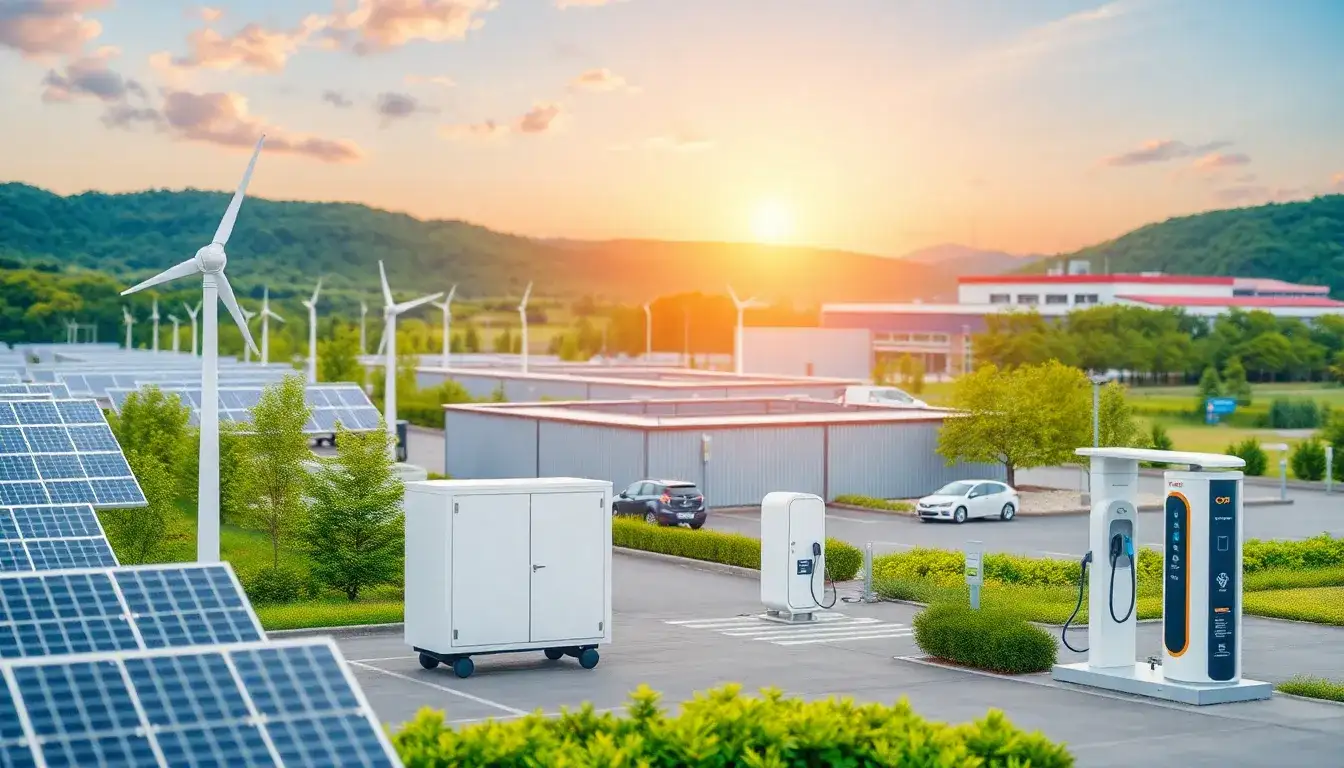
Analysis of Integrated Development Paths for Solar Energy, Storage, and Charging in Jiangsu: A Case Study of an Industrial Park Project
1. Policy Background and Project Positioning
Jiangsu Province has emerged as a leader in energy transition in China, actively promoting the integrated development of solar energy, storage, and charging systems in line with the “dual carbon” goals. In 2024, Jiangsu released the “Implementation Plan for High-Quality Development of New Energy (2024-2027),” which emphasizes the construction of a new power system centered around “photovoltaics + storage + charging.” The plan aims to establish 1,500 integrated demonstration projects covering industrial parks, transportation hubs, and public service facilities by 2027. To support these initiatives, specific subsidy policies have been introduced, such as a one-time subsidy of 200 CNY per kWh for storage projects, and preferential electricity pricing for companies consuming green electricity.
As of March 2025, Jiangsu has implemented 320 integrated solar energy, storage, and charging projects, with 65% located in industrial parks, establishing a typical model characterized by “solar priority, storage peak-shaving, and charging interconnectivity.” This article examines the technical paths and economic aspects of a solar energy storage and charging project in a Suzhou industrial park.
2. Case Study: Solar Energy Storage and Charging Integration in a Suzhou Industrial Park
1. Load Characteristics and Technical Path
The park primarily caters to manufacturing production loads and the charging needs of electric transportation vehicles. It features a configuration of 10 MW of solar power, 15 MWh of storage, and 30 fast-charging stations. Through the EnergyX storage strategy, the project achieves dynamic matching of peak and valley loads, resulting in a green electricity self-sufficiency rate exceeding 69%.
2. Economic Key Data
The following table summarizes the core economic data for two operational models:
| Model | Full Investment Return Rate (Post-Tax) | Payback Period (Post-Tax) | Capital Return Rate (Post-Tax) | Capital Payback Period (Post-Tax) |
|---|---|---|---|---|
| Integrated Energy Model | 9.82% | 9 years | 28.37% | 3.91 years |
| Microgrid Model | 27.64% | 4.39 years | 122.07% | 1.77 years |
Note: Data is based on calculations from the EnergyX Designer system, with a static investment of 56.75 million CNY, operating costs of 1.1 million CNY per year, and a financing interest rate of 3.85%. The integrated energy model is billed based on total electricity consumption, while the microgrid model is billed based on solar and storage power generation.
3. Differences Between the Two Models
– **Integrated Energy Model (Full Managed Supply)**:
– This model encompasses the complete energy needs of the enterprise, combining solar generation, storage batteries, and grid power.
– Operational Characteristics: Solar energy and storage are prioritized throughout the day, with grid electricity serving as a backup when needed.
– Current Data: In this project, 30.45% of electricity comes from grid supplementation, with a curtailed electricity rate of only 0.83%.
– **Microgrid Model (Partial Managed Supply)**:
– Here, the energy service provider supplies solar generation and storage, with any shortfall covered by the enterprise purchasing from the grid.
– Operational Characteristics: The model follows a “solar priority” principle, utilizing solar power during the day, storing excess energy in batteries, and using stored energy during peak grid price periods.
– Current Data: Only 1.64% of electricity is purchased from the grid (for storage charging).
Comparison of the two models reveals that:
1) The integrated energy model offers convenience but relies more on grid electricity, while the microgrid model requires the enterprise to purchase electricity but has lower grid dependence.
2) Both models achieve over 98% efficient use of clean energy, reducing carbon emissions by 65%, aligning with Jiangsu’s industrial carbon peak requirements.
3) In the microgrid model, self-purchased electricity constitutes only 1.2%, leveraging high proportions of green electricity and storage arbitrage, making it suitable for price-sensitive scenarios.
4. Factors Driving Returns and Policy Synergy
– **Innovation in Pricing Mechanisms**: Jiangsu has adopted a “time-of-use pricing + demand response subsidies” strategy, with peak-to-valley price differentials reaching 3.4 times, and storage arbitrage revenue accounting for 45%.
– **Charging Service Premium**: Charging services can charge a premium for green electricity certification, adding 0.6 CNY per kWh, with average daily charging revenue exceeding 18,000 CNY.
– **Storage Arbitrage Strategy**: The use of the EnergyX AI prediction algorithm keeps the curtailment rate below 1.5%, optimizing performance by 40% compared to traditional models.
– **Policy Benefits**: Jiangsu offers “investment subsidies + operational rewards” for solar and storage projects, with storage subsidies reaching up to 200 CNY/kWh and additional rewards for enterprises consuming green electricity.
3. Industry Insights and Promotion Value
1. **Economic Breakthroughs**: The microgrid model exhibits a capital return rate exceeding 95%, demonstrating the replicability of “solar energy, storage, and charging integration” in commercial and industrial settings.
2. **Technological Collaborative Innovation**: Implementing new technologies like heterojunction photovoltaics and sodium-ion batteries can further reduce costs and enhance efficiency.
3. **Policy Synergy Effects**: Leveraging Jiangsu’s distributed photovoltaic installation goals (60 GW) during the 14th Five-Year Plan, projects can be rapidly scaled through “special bonds + green finance.”
4. Nengy Technology: Pioneer in Energy Digitalization
Beijing Nengy Digital Technology Co., Ltd. is recognized as a national high-tech enterprise and a dual-software certified unit, consistently focusing on innovation and research in the energy digitalization sector. With a registered capital of 10 million CNY, Nengy’s core products encompass smart energy economic evaluation systems, integrated energy planning platforms, smart energy operation data engines, and digital energy cloud solutions. The company is dedicated to driving industry transformation through technological innovation, providing comprehensive lifecycle solutions from project planning and economic evaluation to operational management, empowering enterprises toward low-carbon transitions and sustainable green energy development.
Nengy invites partners in the energy sector to explore the new future of smart energy together, collaboratively creating more green value for our planet!







